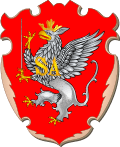Duchy of Livonia
| Duchy of Livonia Księstwo Inflanckie (pl) Herzogtum Livland (de) Ducatus Ultradunensis (la) | |||||
| Vassal of Grand Duchy of Lithuania, then of the Polish–Lithuanian Commonwealth | |||||
| |||||
|
Coat of arms | |||||
.png) | |||||
| Capital | Fellin (Viljandi) 58°22′N 25°36′E / 58.367°N 25.600°ECoordinates: 58°22′N 25°36′E / 58.367°N 25.600°E | ||||
| Government | Principality | ||||
| Grand Duke of Lithuania and King of Poland | |||||
| • | 1561-72 | Sigismund II Augustus | |||
| • | 1573–75 | Henry III de Valois | |||
| • | 1576–86 | Stephen Báthory and Anna Jagiellon | |||
| • | 1588–1621 | Sigismund III Vasa | |||
| Governor | |||||
| • | 1566–78 | Jan Hieronimowicz Chodkiewicz | |||
| Historical era | Early Modern Age | ||||
| • | Wilno Pact | November 28, 1561 | |||
| • | Polish–Swedish War | 1620–22 | |||
| • | Treaty of Altmark | September 25, 1629 1621 | |||
| • | 1st Partition of Poland | August 5, 1772 | |||
The Duchy of Livonia[2] (Polish: Księstwo Inflanckie;[3] Latin: Ducatus Ultradunensis; Estonian: Üleväina-Liivimaa hertsogkond; Latvian: Pārdaugavas hercogiste; also referred to as Polish Livonia or Inflanty[4]) was a territory of the Grand Duchy of Lithuania—and later the Polish–Lithuanian Commonwealth—that existed from 1561 to 1621. It corresponds to the present-day areas of northern Latvia and southern Estonia.
History
Livonia had been part of the Grand Duchy of Lithuania from 1561, since the Livonian Order was secularized by the Union of Vilnius and the Livonian Confederation dissolved during the Livonian Wars. Part of Livonia, formed the Duchy of Courland and Semigallia, while the south-west part of today's Estonia and north-east part of today's Latvia, covering what is now Vidzeme and Latgale, were ceded to the Grand Duchy of Lithuania.
In 1566, it was declared as the Duchy of Livonia according to the Treaty of Union between the landowners of Livonia and authorities of Lithuania; Jan Hieronimowicz Chodkiewicz became the first Governor of the Duchy (1566–1578) in Sigulda Castle. It was a province of Grand Duchy of Lithuania until 1569. After the Union of Lublin in 1569, it became a joint domain of the Polish Crown and the Grand Duchy.
The larger part of the Duchy was conquered by Swedish Empire during the Polish–Swedish wars, and their gains were recognized in the Truce of Altmark in 1629. The Commonwealth retained southeastern parts of the Wenden Voivodeship, renamed to Inflanty Voivodeship with the capital in Daugavpils (Dyneburg), until the first Partition of Poland in 1772, when it was annexed by Catherine the Great's Russian Empire. The title "Grand Duke of Livonia" was added to the grand title of later Russian Emperors.
Administrative divisions
- Dorpat Voivodeship (Dorpat) from 1598 to the 1620s
- Parnawa Voivodeship (Parnawa) from 1598 to the 1620s
- Wenden Voivodeship (Wenden) from 1598 to the 1620s
See also
- Inflanty Voivodeship from the 1620s to 1772
- Bishopric of Ösel-Wiek
 |
 |
References
- ↑ Although colored green, the island of Oesel was not part of Sweden until 1645 and belonged to Danish Crown. It was ceded to Sweden along with Gotland after signing the Second Treaty of Brömsebro (1645).
- ↑ Trade, Diplomacy and Cultural Exchange: Continuity and Change in the North ISBN 90-6550-881-3, p 17
- ↑ Foreword to the Past By Endre Bojtár; p176 ISBN 978-963-9116-42-9
- ↑ Plakans, Andrejs (2011). A Concise History of the Baltic States. Cambridge University Press. p. 95. ISBN 0-521-54155-7.

